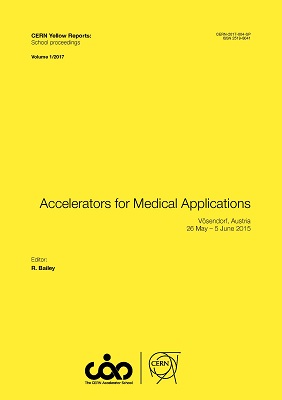Future Trends in Linacs
DOI:
https://doi.org/10.23730/CYRSP-2017-001.151Keywords:
Linacs, spot scanning, single-room facility, multi-painting, hadron therapy.Abstract
High-frequency hadron-therapy linacs have been studied for the last 20 years and are now being built for dedicated proton-therapy centres. The main reason for using high-frequency linacs, in spite of the small apertures and low-duty cycle, is the fact that, for such applications, beam currents of the order of a few nA and energies of about 200 MeV are sufficient. One of the main advantages of linacs, pulsing at 200–400Hz, is that the output energy can be continuously varied, pulse-by-pulse, and a moving tumour target can be covered about ten times in 2–3 minutes by deposing the dose in many thousands of ‘spots’. Starting from the first proposal and the on-going projects related to linacs for medical applications, a discussion of the trend of this field is presented focussing, in particular, on the main challenges for the future, such as the reduction of the footprint of compact ‘single-room’ proton machines and the power efficiency of dual proton and carbon-ion ‘multi-room’ facilities.Downloads
Published
2017-06-22
Issue
Section
Articles
License
Authors who publish with this publication agree to the following terms:
- CERN retains copyright and publishes the work licensed under the Creative Commons Attribution License 4.0 that allows others to share the work with an acknowledgement of the work's authorship and initial publication in this series.
- Authors are able to enter into separate, additional contractual arrangements for distribution of the published version of the work (e.g., post it to an institutional repository or publish it in a book), with an acknowledgement of its initial publication in this series.
- Authors are permitted and encouraged to post their work online (e.g., in institutional repositories or on their website) prior to and during the submission process, as it can lead to productive exchanges, as well as earlier and greater citation of published work (See The Effect of Open Access).

